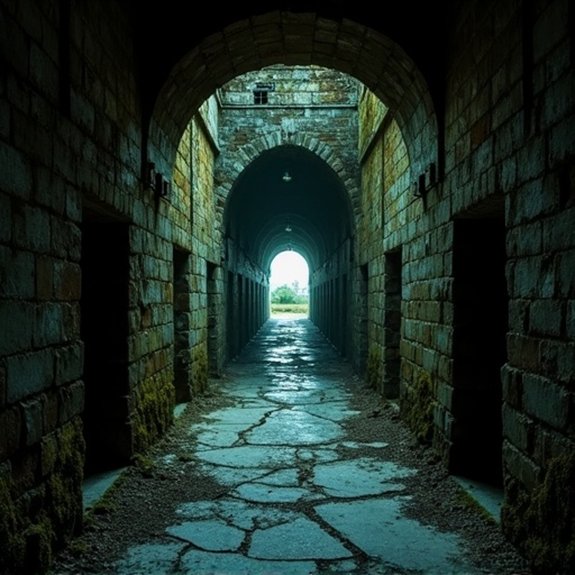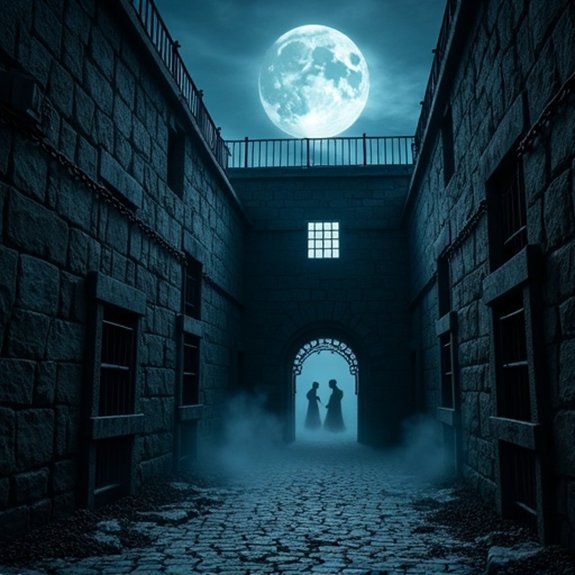Haunted Prisons: Beyond Alcatraz
While Alcatraz’s ghostly reputation captures headlines, America’s lesser-known penitentiaries harbor darker secrets. Eastern State’s crumbling cellblocks echo with phantom footsteps, and Ohio State Reformatory’s shadows move without explanation. These forgotten fortresses of suffering don’t just preserve history—they’ve trapped something else within their walls. What visitors encounter there challenges everything they thought they knew about death’s finality.
Introduction

Behind the thick stone walls and rusted iron bars of abandoned prisons, something sinister often lingers long after the last inmates have gone. These forsaken penitentiaries don’t just hold memories of violence and despair—they’re said to trap the spirits of those who died within their confines. From Eastern State Penitentiary’s shadowy cellblocks to the Ohio State Reformatory’s gothic towers, America’s most notorious lockups have earned reputations as paranormal hotspots.
Investigators report unexplained footsteps echoing through empty corridors, cell doors slamming without cause, and ghostly figures wandering the yards. Former guards and inmates share chilling accounts of encounters that defy logic. Whether one believes in the supernatural or not, these decaying institutions possess an undeniable atmosphere that sends shivers down visitors’ spines.
Ancient Dungeons Birthed Legends
Long before modern prisons housed criminals in concrete cells, medieval dungeons carved deep beneath castles and fortresses became breeding grounds for supernatural tales that persist centuries later. The Tower of London’s White Tower holds England’s most infamous spirits—Anne Boleyn’s headless ghost reportedly walks its corridors where she met her execution. Edinburgh Castle’s dungeons echo with phantom drumming from a headless drummer boy who warned of attacks in 1650. France’s Château d’If, immortalized in Dumas’s fiction, draws visitors seeking glimpses of actual prisoners’ ghosts who died in isolation. These ancient stone chambers trapped more than bodies. They’ve preserved centuries of suffering, creating atmospheric conditions that paranormal investigators claim amplify spiritual activity. Today’s tourists flock to these sites, drawn by histories where documented executions merge with unexplained phenomena.
Notable Cases or Sightings

While skeptics dismiss them as folklore, specific paranormal encounters at haunted prisons have gained credibility through multiple witness accounts and documented evidence. Eastern State Penitentiary’s guards reported seeing Al Capone’s ghost in his former cell, where he’d spent months in isolation. Multiple visitors photographed unexplained shadows and captured EVP recordings of voices in empty cellblocks.
Ohio State Reformatory’s documented cases include prison staff witnessing apparitions of executed inmates near the electric chair’s former location. Guards filed official reports describing cell doors slamming without cause and hearing footsteps in abandoned wings. At West Virginia Penitentiary, tour guides’ve recorded temperature drops of twenty degrees in specific cells where inmates died violently. Security cameras captured orbs and moving shadows when buildings stood empty overnight.
Common Theories or Explanations
The intense emotional energy trapped within prison walls offers paranormal researchers a primary explanation for ghostly phenomena. They believe violent deaths, executions, and prolonged suffering create residual imprints that manifest as apparitions or unexplained sounds.
Stone tape theory suggests limestone and quartz in prison construction act as recording devices, capturing traumatic events and replaying them under specific conditions. This explains why witnesses report seeing the same ghostly scenes repeatedly.
Skeptics attribute sightings to environmental factors. Old prisons’ poor ventilation creates carbon monoxide buildup, causing hallucinations. Infrasound from settling foundations produces feelings of dread and visual disturbances. Additionally, suggestibility plays a role—visitors expecting paranormal encounters interpret normal sounds as supernatural.
Some psychologists argue that collective trauma leaves psychological imprints affecting sensitive individuals who visit these locations.
Frequently Asked Questions
Can Visitors Participate in Overnight Ghost Hunting Experiences at These Haunted Prisons?
Yes, several haunted prisons offer overnight ghost hunting experiences where visitors can explore cellblocks, use paranormal equipment, and investigate reportedly active areas. Places like Eastern State Penitentiary and Ohio State Reformatory regularly host these events.
What Safety Precautions Should Paranormal Investigators Take When Exploring Abandoned Prison Sites?
Paranormal investigators shouldn’t explore abandoned prisons without proper permits, structural assessments, and safety equipment. They’ll need flashlights, first-aid kits, protective gear, and communication devices. Working in teams guarantees someone’s always monitoring for physical hazards and emergencies.
Are There Any Documented Cases of Prison Staff Refusing to Work Certain Areas?
Yes, guards at Eastern State Penitentiary have documented refusing to patrol cellblock 12 after reporting shadow figures. West Virginia Penitentiary’s staff wouldn’t enter the sugar shack area alone following multiple unexplained incidents in the 1980s.
Which Haunted Prisons Offer the Most Affordable Guided Tours for Budget Travelers?
Eastern State Penitentiary in Philadelphia offers tours starting at $19, while Ohio State Reformatory’s self-guided tours cost just $15. West Virginia Penitentiary’s rates begin at $13, making it one of America’s most affordable haunted prison experiences.
Do Any Former Inmates Report Continuing Paranormal Experiences After Their Release?
Yes, several former inmates from Eastern State Penitentiary and Ohio State Reformatory report they’re still experiencing nightmares, unexplained cold spots in their homes, and hearing phantom cell doors slamming years after their release.
Related Posts

The Temple of the Jaguar God

The Poltergeist of Rosenheim: Germany’s Case
